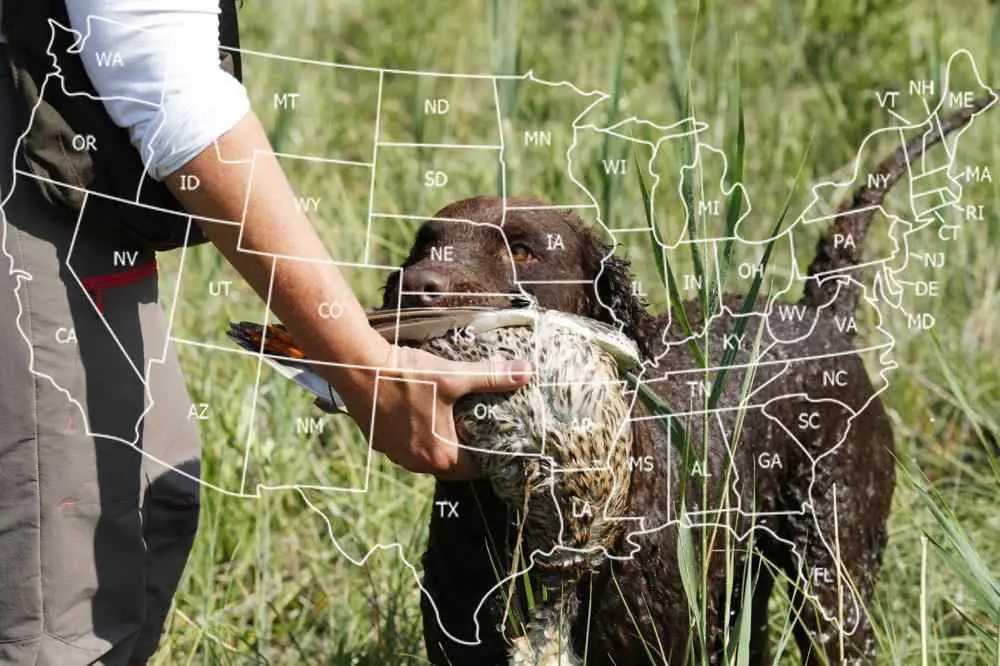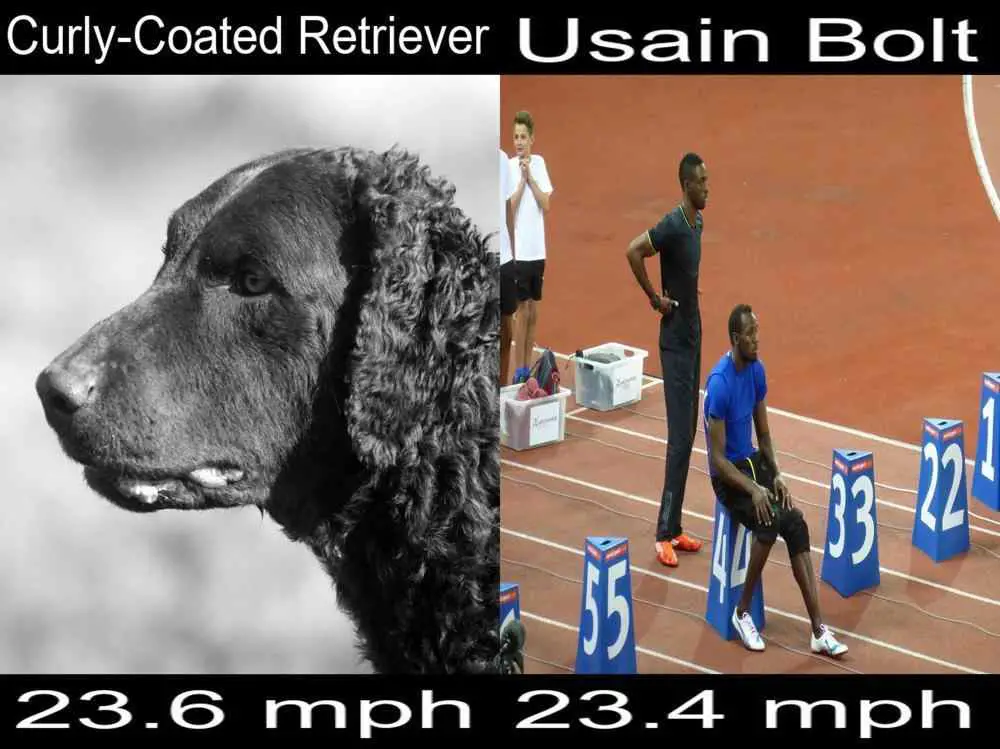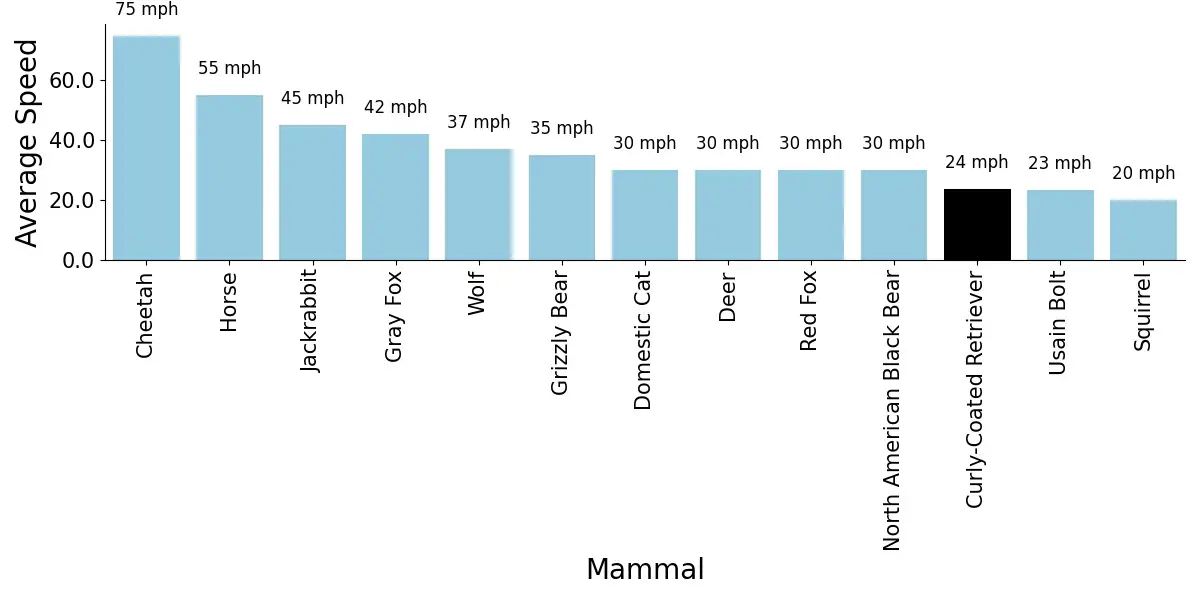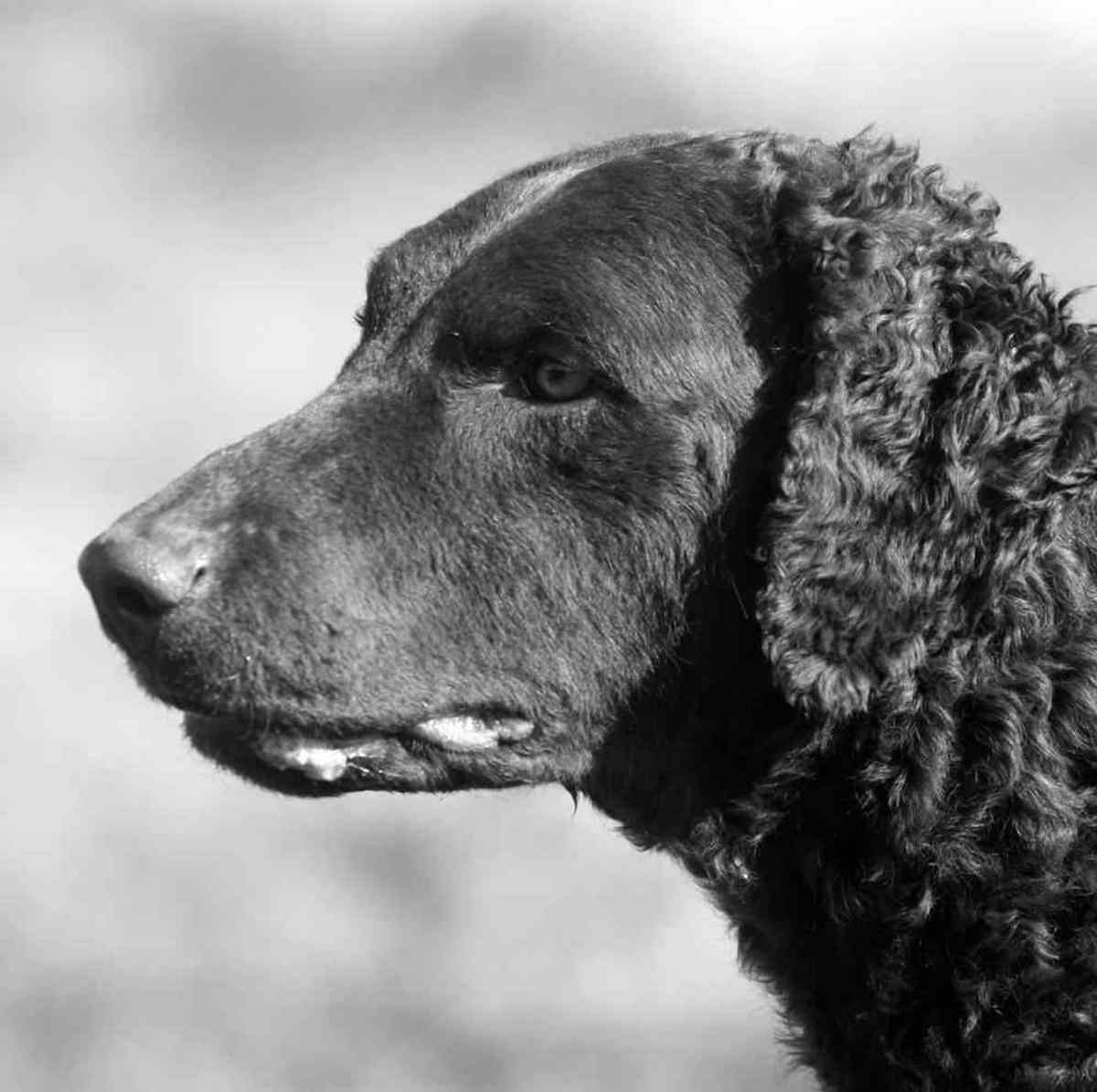Quick Links: Table of Contents
- Curly-Coated Retriever Breed Overview
- History of the Curly-Coated Retriever Breed. Where Curly-Coated Retrievers came from
- What the Curly-Coated Retriever Looks Like
- Best Curly-Coated Retriever Breeders
- Curly-Coated Retriever Litter Size
- How Fast Curly-Coated Retrievers Can Run
- Good Names for Curly-Coated Retrievers
- How Intelligent are Curly-Coated Retrievers?
- How Popular are Curly-Coated Retrievers with New Dog Owners?
- Health Problems in Curly-Coated Retrievers and How to Prevent Them
- Dog Breeds That Are Similar to Curly-Coated Retrievers
- Other Things to Know About Curly-Coated Retrievers
Curly-Coated Retriever Breed Overview
The Curly-Coated Retriever is a medium-sized dog.
The adult Curly-Coated Retriever stands 1 foot, 11 inches to 2 feet, 3 inches tall at the .
The Curly-Coated Retriever belongs to the Sporting Dogs group.
Dogs in the Sporting Dogs group, like the Curly-Coated Retriever, were bred to help hunters catch and retrieve feathered game. Some sporting dog breeds such as Retrievers, which were built for swimming, were bred to hunt waterfowl in water.
Whereas sporting dog breeds like setters, spaniels, and pointing breeds were bred to hunt quail, pheasant, and other game birds nest on grasslands.
Many Sporting Group breeds have thick, water-repellent coats that protect them from harsh hunting conditions.
The fact that Curly-Coated Retrievers belong to the Sporting Dogs group is one of the reasons why Curly-Coated Retrievers have the personality and temperament that they have.
The temperament of the Curly-Coated Retriever is generally described as:
- Clever
- Independent
- Intelligent
- Lively
- Sensitive
- Trainable
History of the Curly-Coated Retriever Breed. Where Curly-Coated Retrievers came from
The Curly-Coated Retriever is a breed of dog that was originally developed in England.
The breed is thought to be a cross between the Curly-Coated Retriever and the Poodle, and it is believed that the Curly-Coated Retriever was brought to England in the late 1800s.
The Curly-Coated Retriever is a large breed of dog, and it is characterized by its curly coat and long, loping gait.
The breed is an excellent swimmer, and it is often used as a hunting dog.
The Curly-Coated Retriever is an intelligent breed of dog, and it is known for its loyalty and devotion to its owners.
The Curly-Coated Retriever is an active breed of dog, and it needs plenty of exercise.
The breed is also known for its independent nature, and it can be stubborn at times.
The Curly-Coated Retriever is an overall healthy breed of dog, but it is susceptible to some health problems, such as hip dysplasia and elbow dysplasia.
.
What the Curly-Coated Retriever Looks Like
The Curly-Coated Retriever is a large breed of dog, standing 24 to 27 inches tall at the shoulder and weighing 60 to 70 pounds.
They are easily recognized by their curly, water-resistant coat, which can be black, liver, or blue-merle in color.
Curlies are active dogs, with plenty of energy for hiking, swimming, and other outdoor activities.
They are also intelligent and trainable, making them popular choices for obedience and agility competitions.
Curlies are loyal and affectionate with their families, but they can be reserved around strangers.
With proper socialization, however, they will learn to welcome visitors into their home.
Curly-Coated Retrievers make great companions for active families and individuals.
.
Best Curly-Coated Retriever Breeders

We have researched reputable Curly-Coated Retriever breeders that you can buy a puppy.
Go to this page for our complete list of reputable Curly-Coated Retriever breeders in various states in the United States.
On this page, you will see how much these breeders sell their puppies for, and how many puppies they have available.
A few of these breeders are listed below.
Sonia Evans
Puppy Price: Check with breeder
Tyneside Curlies
Puppy Price: Check with breeder
Addidas Curly Coated Retrievers
Puppy Price: Check with breeder
Tephra Curly Coated Retrievers
Puppy Price: Check with breeder
Curly-Coated Retriever Litter Size
Researchers from the Norwegian School of Veterinary Science did a study where they counted the numbers of puppies in 4 different Curly-Coated Retriever birth litters.
From this study, the researchers found that the average number of puppies that Curly-Coated Retrievers can have is 7 puppies. Also, the Curly-Coated Retriever can have as few as 6 puppies per litter and as many as 10 puppies per litter.
The number of puppies that the Curly-Coated Retriever will have depends on factors such as the age of the Curly-Coated Retriever, the method of pregnancy, etc.
Click here to see our calculator for predicting how many puppies your Curly-Coated Retriever will have and how the litter size of the Curly-Coated Retriever compares to the litter size of other dog breeds.
How Fast Curly-Coated Retrievers Can Run

How fast a dog breed can run is a good measure of how athletic the dog breed is.
The American Kennel Club (AKC) regularly conducts dog running competitions. The AKC records the running speed of competing dogs in these competitions. These competitions are open to all dog breeds.
Based on our analysis of the speeds of 30 different Curly-Coated Retrievers, the average speed of the Curly-Coated Retriever is 23.6 mph (37.9 kmph).
The fastest speed on AKC record that the Curly-Coated Retriever ran in a race is 29.22 mph (47.0 kmph) and the minimum speed on record in a race for a Curly-Coated Retriever is 3.58 mph (5.8 kmph).
Click here to see how the speed of the Curly-Coated Retriever compares to the speed of other dogs and other mammals such as cats, horses, humans, etc.

Good Names for Curly-Coated Retrievers
Here are some really good names that are typical for the Curly-Coated Retriever ranked by popularity:
- Cole
How Intelligent are Curly-Coated Retrievers?
| Curly-Coated Retriever | |
|---|---|
| Intelligence Rank | 41 out of 130 dog breeds |
| Trainability | Tend To Learn New Commands After 25 To 40 Repetitions |
According to Prof. Stanley Coren, a Canadian psychology professor/dog trainer, the total intelligence that a dog demonstrates is the addition of three types of intelligence. These intelligence types are:
- Instinctive Intelligence: This is the natural intelligence that comes from instinct. For example, dog breeds that have been historically bred to be guard dogs will have a high `guarding` intelligence compared to dogs that were not bred for guarding.
- Adaptive Intelligence (learning and problem-solving ability): This indicates what a dog can learn to do for himself or herself. Adaptive intelligence is specific to each dog, and not breed specific. You can improve your dog`s adaptive intelligence by investing time to train your dog.
- Working/Obedience Intelligence: This type of intelligence is breed-specific. Certain dog breeds tend to have higher working/obedience intelligence than some other breeds. This intelligence is the closest to what we might call school-learning ability and it is based upon what the dog can learn to do when instructed by humans. This type of intelligence can be measured for each dog breed and compared to that of other dog breeds.
Professor Stanley Coren measured and ranked the working intelligence of about 130 different dog breeds.
Prof. Coren found that the Curly-Coated Retriever has an obedience intelligence rank of 41 out of 130 dog breeds. Thus, Prof. Coren put Curly-Coated Retrievers in the `Average Working/Obedience Intelligence Dogs` category.
This means that Curly-Coated Retrievers tend to learn new commands after 25 to 40 repetitions.
However, we should mention that a dog should not be judged based on its intelligence alone. There are other important factors you need to consider when deciding on which dog breed to get. These other factors include sociability, adorability, and compatibility of the dog breed with your lifestyle.
See the intelligence ranking of some other dog breeds below:
| Breed | Intelligence Rank |
|---|---|
| Border Collie | 1 |
| German Shepherd Dog | 3 |
| Golden Retriever | 4 |
| Doberman Pinscher | 5 |
| Shetland Sheepdog | 6 |
| Papillon | 8 |
| English Springer Spaniel | 13 |
| Cocker Spaniel | 20 |
| Cardigan Welsh Corgi | 26 |
| Border Terrier | 30 |
| Samoyed | 33 |
| American Staffordshire Terrier | 34 |
| Cairn Terrier | 35 |
| Dalmatian | 39 |
| Kuvasz | 42 |
| American Foxhound | 46 |
| Rhodesian Ridgeback | 52 |
| Old English Sheepdog | 63 |
| Chow Chow | 76 |
| American Bulldog | 77 |
How Popular are Curly-Coated Retrievers with New Dog Owners?
Every year, the American Kennel Club (AKC) publishes information on how popular a dog breed is in that particular year. The AKC gets the popularity information of a breed from how many dogs of that breed the owners register with the AKC every year. The AKC collects this data for about 200 dog breeds.
The graph below shows the popularity trend of the Curly-Coated Retriever.
The popularity of the Curly-Coated Retriever averaged over the years is Number 162 out of about 200 dog breeds.
Do not get a dog breed just because it is a popular dog breed. And do not reject a dog breed just because it is an unpopular breed.
Health Problems in Curly-Coated Retrievers and How to Prevent Them
Every dog breed has its own set of health problems that it tends to develop. There is nothing like a perfect dog breed.
The Curly-Coated Retriever is prone to certain genetic health conditions. The Orthopedic Foundation for Animals (OFA) is an organization that keeps track of genetic health problems in dog breeds.
From the extensive records that the OFA keeps, the OFA knows what health problems each dog breed is naturally prone to develop.
Hence, the OFA recommends which health screening breeders should perform on a dog breed to make sure that the breeders won`t breed `defective` dog parents that can pass down defective genes to their puppy offspring.
If you want a Curly-Coated Retriever puppy that will grow up to be healthy, make sure that your Curly-Coated Retriever breeder screens your puppy or your puppy`s parents for the health problems that the OFA recommends for your puppy`s breed. This will increase the chances that your puppy is free from genetic defects.
The following are the health tests that Orthopedic Foundation for Animals (OFA) recommends that breeders should screen Curly-Coated Retrievers for:
- Cardiac Evaluation
- Cord-1 PRA
- EIC (Exercise Induced Collapse)
- Elbow Dysplasia
- Eye Examination
- GSD IIIa
- Hip Dysplasia
You can find out more about OFA`s recommended tests for Curly-Coated Retrievers here.
Dog Breeds That Are Similar to Curly-Coated Retrievers
If you have not made up your mind on which dog breed to get, you may also want to consider some other dogs similar to the Curly-Coated Retriever.
We crunched the numbers and found that the following dog breeds that have similar behavior and temperament as the Curly-Coated Retriever:
- Airedale Terrier (82 percent match with Curly-Coated Retriever). Learn more about the Airedale Terrier here.
- German Shorthaired Pointer (78 percent match with Curly-Coated Retriever). Learn more about the German Shorthaired Pointer here.
- English Springer Spaniel (79 percent match with Curly-Coated Retriever). Learn more about the English Springer Spaniel here.
- Irish Setter (82 percent match with Curly-Coated Retriever). Learn more about the Irish Setter here.
Other Things to Know About Curly-Coated Retrievers
Here are some of the very important characteristics of the Curly-Coated Retriever that you need to know about the Curly-Coated Retriever breed:

